Located in Newbliss, Co Monaghan, Mark Niblock runs a small agricultural contracting business.
Predominately working as a one-man band, he decided to move to a combination baler-wrapper.
Running his own contracting business since 2016, Mark has a wealth of machinery knowledge, backed up by a long number of years working for local contractors.

Mark Niblock, Newbliss, Co Monaghan.
He said an opportunity came up to take over the business from a good friend he had worked for. “I often thought about setting up my own business, but I knew it would be next to impossible to make it work starting from nothing. With the number of contractors about now and the price of machinery, it’s a hard business to get started in. Only that such an opportunity came up leaving a customer base, I don’t think I’d have went at it.”
Mark started out with a new McHale F5500 in 2016. Everything was going well. The only issue was trying to organise someone to wrap when his brother wasn’t about. This got him thinking about going down the combi baler-wrapper route.
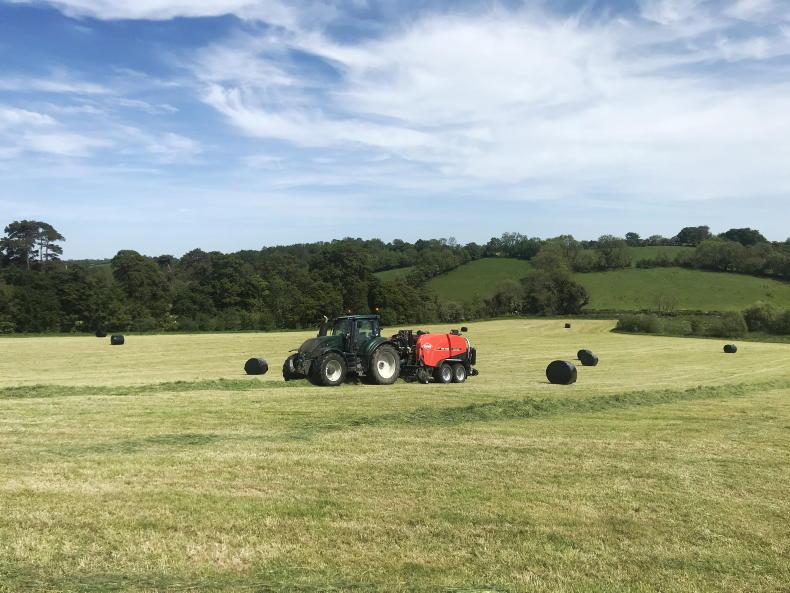
Mark is happy having opted for the Kuhn combi unit.
Mark said: “I saw the Kuhn FBP 3135 working at the last Grass & Muck – it impressed me. There also used to be Deutz balers working about here which were essentially a Kuhn machine. They too were a good baler overall.”
Mark made contact with a well-known contractor in the North who has a long-standing history of Kuhn balers and got his opinion on the FBP 3135.
He decided to go with Kuhn, striking a deal with Martins Garage, his local Kuhn dealer, and took delivery of a new FBP 3135 ahead of the 2020 season. The McHale 5500 still remains in the fleet and is called into action too during the busy periods.
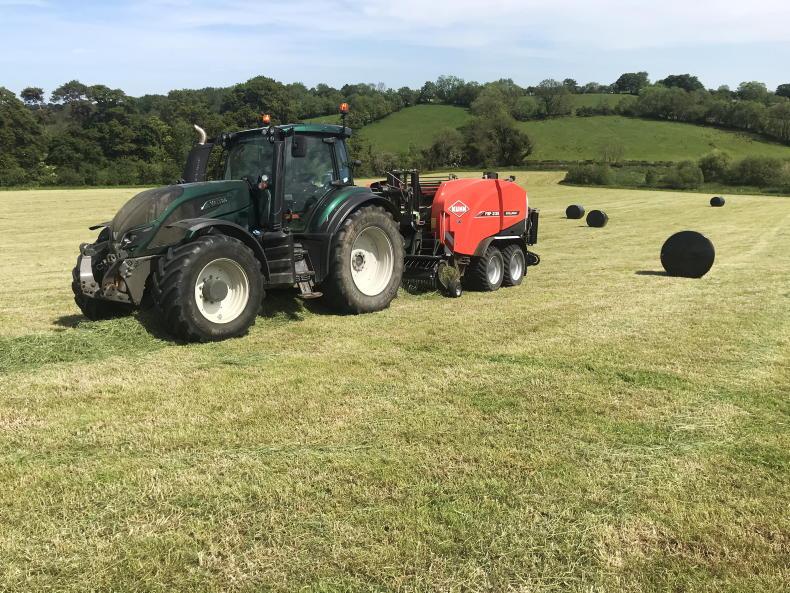
Regardless of row size or crop type, Mark can't fault the baler's intake.
Pickup and rotor
The FBP 3135’s ability to take in grass is a key feature for Mark. It is fitted with a 2.3m pickup complete with five tine bars which run on a cam track. He said the pickup follows the ground very well, putting a lot of this down to the positioning of the pickup wheels. The wheels remain within the width of the baler, so removal isn’t necessary for transport. This eliminates the need to leave the cab between fields, Mark said.
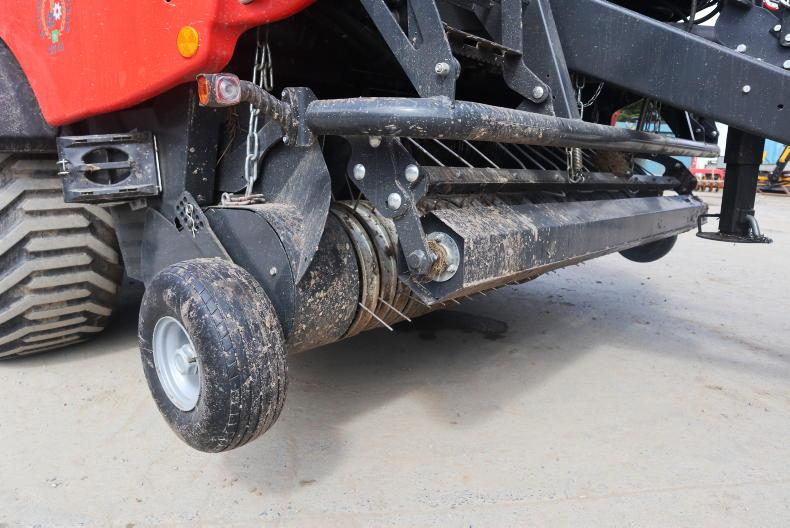
Mark likes that pickup wheels do not need to be removed for transport.
The FBP 3135 is fitted with the Opticut 23 rotor which spans the full width of the pickup. The close positioning between the pickup tines and the Hardox steel rotor makes for a smooth, steady crop flow, regardless of crop length. Mark said the rotor’s integrated augers at either end stops grass getting caught, and causing blockages.
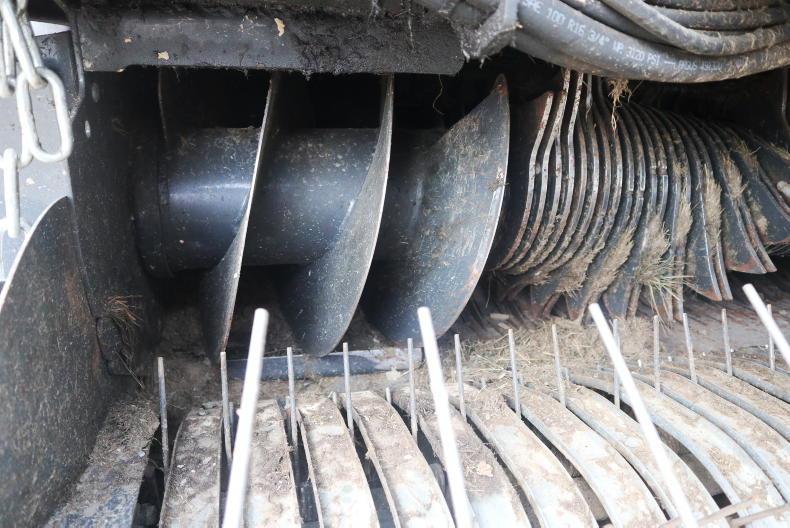
The rotor spans the full width of the pickup.
Although the baler is fitted with a drop floor, Mark said it has been rarely used. This, he believes is down to the pickup and rotor disengagement function.
If the baler blocks while the chamber is nearly full and net or film is about to be applied, causing the slip clutch to go off, the pickup and rotor can be disengaged at the press of a button.
The bale can then be bound and discharged from the chamber without more grass being fed in.
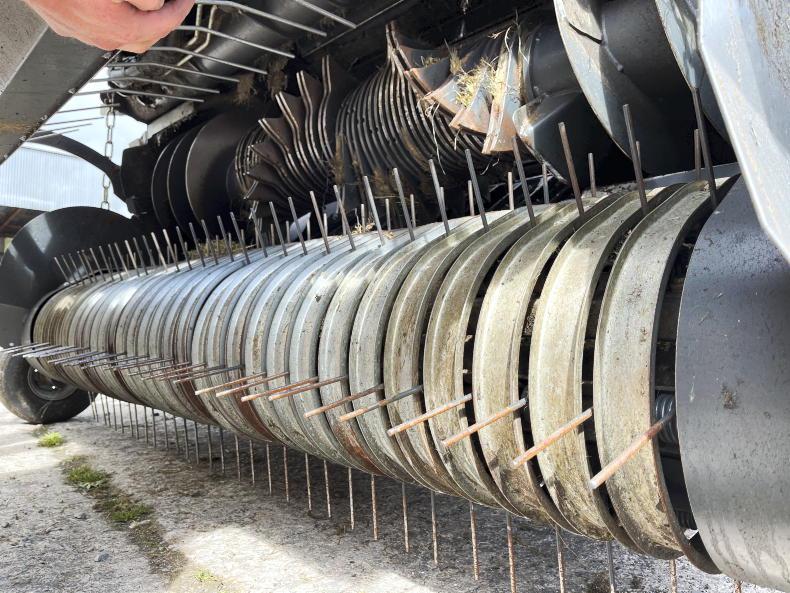
The pickup tines and rotor tines are positioned close together, leaving good crop flow.
Mark finds it a great feature when crossing rows with a full chamber, saving having to turn off the PTO with a full chamber. The pickup and rotor disengages by means of a hydraulically engaged dog clutch.
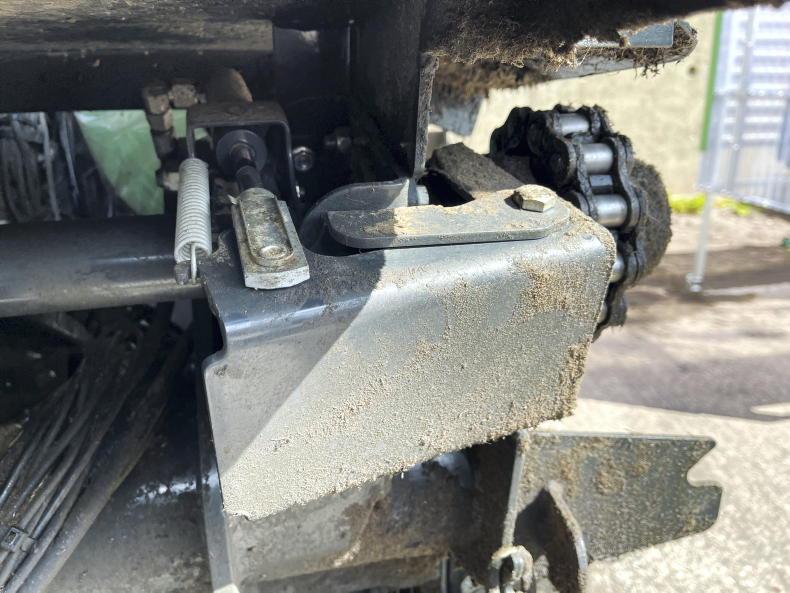
A hydraulically operated dog clutch can engage or disengage the pickup and rotor separate to the chamber.
Chopping unit
Behind the rotor is the 23-knife selectable knife bank, which can provide a theoretical chop length as short as 45mm. Knife combinations of 0,7,11, 12 or 23 can be selected manually.

The chamber is fitted with 18 rollers made from 3.2mm thick steel.
Mark said it would be nice if combinations could be selected from the cab. He tends to alternate between 11 knives one day and 12 knives the next, for longer sharpening intervals.
“Sometimes when engaging knives that haven’t been in use for a while, chaff might cause one or two to stick and require a light tip of a hammer.
“Chop consistency is good. I’d put a lot of it down to the fact knives are a good length, passing well through the rotor tines, creating a good cut.”
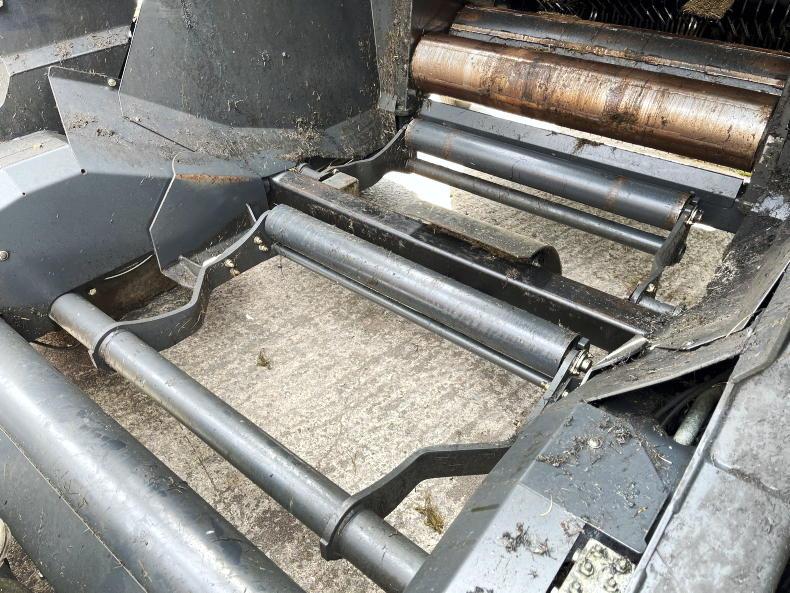
The transfer system uses two transfer arms.
The knives are automatically cleaned at set intervals. This is done by lowering and raising the knives to remove any debris.
Net/film binding
Both net and film can be left in position for binding. Mark just has to change the feed-in of the desired material, terminal settings and the tension setting on the pulley on the side of the intake roller.
He said a lot of customers are moving towards the conventional black film over net. Two rolls need to be inserted so that the full width of the bale is covered, with two rolls lasting for roughly 150 bales, he said. The bottom roller on the chamber door disengages as the bale is ejected to prevent the film being damaged.
Mark said replacing film rolls is quick and easy but when replacing net, especially if switching between brands, tension settings may need to be changed.
Chamber
The chamber consists of 18 rollers made from 3.2mm thick steel. The drive side of each is fitted with 50mm double-raced bearings, with all bearings centrally greased using the Beka Max automatic greasing system. Mark said the only downside with the auto greaser is that it doesn’t grease the wrapper unit.

The auto greaser is a great feature but could be improved by greasing the wrapper too.
The rollers have scrapers built in to push material away from the bearings. The pickup and rotor are driven from the left, while all 18 rollers are driven from the right.
Sensors on the rear chamber door monitor bale formation from 80% and inform the operator through the terminal whether to fill either the left or right side of the chamber more. Mark said this feature works well, keeping bales consistently well shaped.
Transfer and wrapping
The transfer system consists of two transfer arms. The first catches the bale as it leaves the chamber, passing it on to the main transfer arm and then on to the table. Mark has his machine fitted with the optional hill kit, which helps transfer the bale straight back. Although, not the fastest transfer system on the market, he says it’s smooth and consistent.

Mark likes the way in which the 3D wrapping system applies film where it is needed most.
When using conventional film, the bale is already 60% covered once on the wrapper. The 3D wrapping system will start by applying film to the edges and barrel of the bale. Once 80% of the bale is covered in film, the remainder is wrapped conventionally. Mark said the 3D system is fast and efficient with wrap when wanting to apply more layers to the barrel where it is needed. All the wrapper and transfer functions can be controlled manually using the valve block and key at the rear of the machine.
One point Mark made was that the wrapper unit sits quite low to the ground and has rubbed of the ground once or twice when entering steep gaps.
As he prepares the FBP 3135 for its second season, Mark is well impressed with the baler so far: “Its intake can’t be faulted. Regardless of row size or if it’s short grass, it’ll still swallow it. Its bales have all been well shaped and solid. A few farmers have even commented over the winter on the chop quality.”

Although Isobus is an option, Mark tends to use the separate control terminal.
Mark’s FBP 3135 is fitted with 500/45 R22.5 tyres which he says, along with the tandem axle, allows the machine to travel the ground well, even in wetter conditions. The low overall height, which he believes contributes to the good crop intake, also means the bale on the wrapping table can be easily seen while it’s being wrapped.
“It has a couple of unique features that stand out, particularly the pickup and rotor disengagement and film binding using conventional film. However, there are a few areas that could be tweaked in its design. Firstly, a longer draw bar, secondly more ground clearance of the wrapper and finally the ability to change knife configurations from the cab.
“The only issue I had last season was a bearing failed in the pickup which was easy enough sorted. To be fair, Kuhn have been out and made a few minor modifications. As well as that, they are keen for feedback on areas to improve on, which is always positive.”
Weight: 5,600kg.
Width: 2.97m (9.41ft).
Length: 6.4m (21.19ft).
Knives: 23-knife selectable floor (combinations; 0-7-11-12-23).
Bale chamber: 18 rollers.
Terminal: Isobus compatible.
Pickup: 2.3m, five tine bar cam track.
List price: €102,000 plus VAT.
Located in Newbliss, Co Monaghan, Mark Niblock runs a small agricultural contracting business.
Predominately working as a one-man band, he decided to move to a combination baler-wrapper.
Running his own contracting business since 2016, Mark has a wealth of machinery knowledge, backed up by a long number of years working for local contractors.

Mark Niblock, Newbliss, Co Monaghan.
He said an opportunity came up to take over the business from a good friend he had worked for. “I often thought about setting up my own business, but I knew it would be next to impossible to make it work starting from nothing. With the number of contractors about now and the price of machinery, it’s a hard business to get started in. Only that such an opportunity came up leaving a customer base, I don’t think I’d have went at it.”
Mark started out with a new McHale F5500 in 2016. Everything was going well. The only issue was trying to organise someone to wrap when his brother wasn’t about. This got him thinking about going down the combi baler-wrapper route.

Mark is happy having opted for the Kuhn combi unit.
Mark said: “I saw the Kuhn FBP 3135 working at the last Grass & Muck – it impressed me. There also used to be Deutz balers working about here which were essentially a Kuhn machine. They too were a good baler overall.”
Mark made contact with a well-known contractor in the North who has a long-standing history of Kuhn balers and got his opinion on the FBP 3135.
He decided to go with Kuhn, striking a deal with Martins Garage, his local Kuhn dealer, and took delivery of a new FBP 3135 ahead of the 2020 season. The McHale 5500 still remains in the fleet and is called into action too during the busy periods.

Regardless of row size or crop type, Mark can't fault the baler's intake.
Pickup and rotor
The FBP 3135’s ability to take in grass is a key feature for Mark. It is fitted with a 2.3m pickup complete with five tine bars which run on a cam track. He said the pickup follows the ground very well, putting a lot of this down to the positioning of the pickup wheels. The wheels remain within the width of the baler, so removal isn’t necessary for transport. This eliminates the need to leave the cab between fields, Mark said.

Mark likes that pickup wheels do not need to be removed for transport.
The FBP 3135 is fitted with the Opticut 23 rotor which spans the full width of the pickup. The close positioning between the pickup tines and the Hardox steel rotor makes for a smooth, steady crop flow, regardless of crop length. Mark said the rotor’s integrated augers at either end stops grass getting caught, and causing blockages.

The rotor spans the full width of the pickup.
Although the baler is fitted with a drop floor, Mark said it has been rarely used. This, he believes is down to the pickup and rotor disengagement function.
If the baler blocks while the chamber is nearly full and net or film is about to be applied, causing the slip clutch to go off, the pickup and rotor can be disengaged at the press of a button.
The bale can then be bound and discharged from the chamber without more grass being fed in.

The pickup tines and rotor tines are positioned close together, leaving good crop flow.
Mark finds it a great feature when crossing rows with a full chamber, saving having to turn off the PTO with a full chamber. The pickup and rotor disengages by means of a hydraulically engaged dog clutch.

A hydraulically operated dog clutch can engage or disengage the pickup and rotor separate to the chamber.
Chopping unit
Behind the rotor is the 23-knife selectable knife bank, which can provide a theoretical chop length as short as 45mm. Knife combinations of 0,7,11, 12 or 23 can be selected manually.

The chamber is fitted with 18 rollers made from 3.2mm thick steel.
Mark said it would be nice if combinations could be selected from the cab. He tends to alternate between 11 knives one day and 12 knives the next, for longer sharpening intervals.
“Sometimes when engaging knives that haven’t been in use for a while, chaff might cause one or two to stick and require a light tip of a hammer.
“Chop consistency is good. I’d put a lot of it down to the fact knives are a good length, passing well through the rotor tines, creating a good cut.”

The transfer system uses two transfer arms.
The knives are automatically cleaned at set intervals. This is done by lowering and raising the knives to remove any debris.
Net/film binding
Both net and film can be left in position for binding. Mark just has to change the feed-in of the desired material, terminal settings and the tension setting on the pulley on the side of the intake roller.
He said a lot of customers are moving towards the conventional black film over net. Two rolls need to be inserted so that the full width of the bale is covered, with two rolls lasting for roughly 150 bales, he said. The bottom roller on the chamber door disengages as the bale is ejected to prevent the film being damaged.
Mark said replacing film rolls is quick and easy but when replacing net, especially if switching between brands, tension settings may need to be changed.
Chamber
The chamber consists of 18 rollers made from 3.2mm thick steel. The drive side of each is fitted with 50mm double-raced bearings, with all bearings centrally greased using the Beka Max automatic greasing system. Mark said the only downside with the auto greaser is that it doesn’t grease the wrapper unit.

The auto greaser is a great feature but could be improved by greasing the wrapper too.
The rollers have scrapers built in to push material away from the bearings. The pickup and rotor are driven from the left, while all 18 rollers are driven from the right.
Sensors on the rear chamber door monitor bale formation from 80% and inform the operator through the terminal whether to fill either the left or right side of the chamber more. Mark said this feature works well, keeping bales consistently well shaped.
Transfer and wrapping
The transfer system consists of two transfer arms. The first catches the bale as it leaves the chamber, passing it on to the main transfer arm and then on to the table. Mark has his machine fitted with the optional hill kit, which helps transfer the bale straight back. Although, not the fastest transfer system on the market, he says it’s smooth and consistent.

Mark likes the way in which the 3D wrapping system applies film where it is needed most.
When using conventional film, the bale is already 60% covered once on the wrapper. The 3D wrapping system will start by applying film to the edges and barrel of the bale. Once 80% of the bale is covered in film, the remainder is wrapped conventionally. Mark said the 3D system is fast and efficient with wrap when wanting to apply more layers to the barrel where it is needed. All the wrapper and transfer functions can be controlled manually using the valve block and key at the rear of the machine.
One point Mark made was that the wrapper unit sits quite low to the ground and has rubbed of the ground once or twice when entering steep gaps.
As he prepares the FBP 3135 for its second season, Mark is well impressed with the baler so far: “Its intake can’t be faulted. Regardless of row size or if it’s short grass, it’ll still swallow it. Its bales have all been well shaped and solid. A few farmers have even commented over the winter on the chop quality.”

Although Isobus is an option, Mark tends to use the separate control terminal.
Mark’s FBP 3135 is fitted with 500/45 R22.5 tyres which he says, along with the tandem axle, allows the machine to travel the ground well, even in wetter conditions. The low overall height, which he believes contributes to the good crop intake, also means the bale on the wrapping table can be easily seen while it’s being wrapped.
“It has a couple of unique features that stand out, particularly the pickup and rotor disengagement and film binding using conventional film. However, there are a few areas that could be tweaked in its design. Firstly, a longer draw bar, secondly more ground clearance of the wrapper and finally the ability to change knife configurations from the cab.
“The only issue I had last season was a bearing failed in the pickup which was easy enough sorted. To be fair, Kuhn have been out and made a few minor modifications. As well as that, they are keen for feedback on areas to improve on, which is always positive.”
Weight: 5,600kg.
Width: 2.97m (9.41ft).
Length: 6.4m (21.19ft).
Knives: 23-knife selectable floor (combinations; 0-7-11-12-23).
Bale chamber: 18 rollers.
Terminal: Isobus compatible.
Pickup: 2.3m, five tine bar cam track.
List price: €102,000 plus VAT.













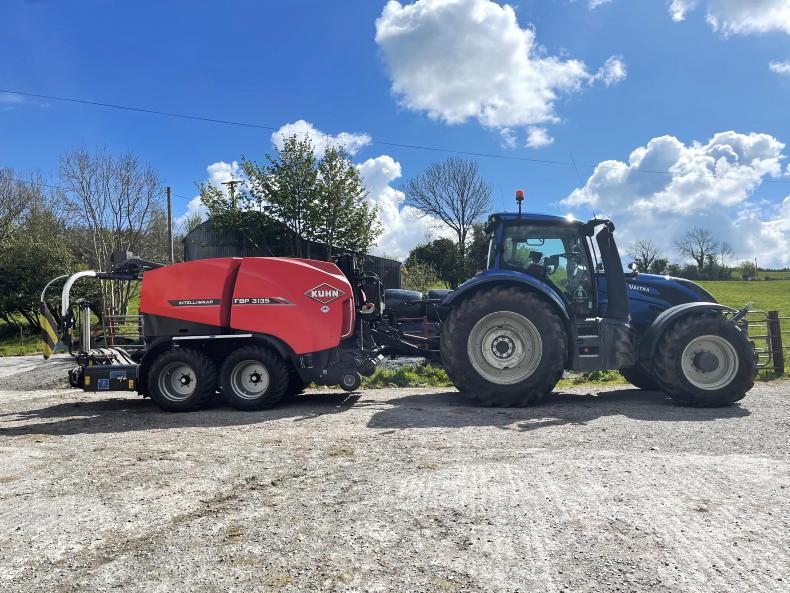




 This is a subscriber-only article
This is a subscriber-only article










SHARING OPTIONS: